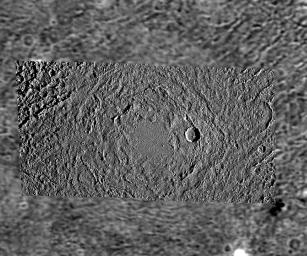
|
Buto Facula - A Palimpsest on Ganymede
- Click the image above for a larger view
- Full-Res JPEG (1078 x 900) (264.9 kB)
- Full-Res TIFF (1078 x 900) (412.8 kB)
Caption:
This image shows a mosaic of Buto Facula, a so-called "palimpsest" situated in Marius Regio on Jupiter's largest satellite Ganymede. Palimpsests are bright, nearly circular patches that are believed to be remnant impact features. They preferentially, but not exclusively, occur in Ganymede's more densely cratered, older, dark terrain units and may also be found on Ganymede's outer neighbor Callisto.
The higher resolution digital image data in the center were obtained by the Solid State Imaging (SSI) camera system onboard the NASA spacecraft Galileo in May 1997 during Galileo's 8th orbit around Jupiter from a distance of about 18,600 km (11,560 miles). The pixel resolution is 180 m/pixel - the smallest features that are still discernible are about 360 m across. The sun illuminates the scene from the right at low angle, so morphological features are accentuated by long shadows. North is pointing towards the top of the mosaic. The lower resolution context in the background is given by Voyager images from 1979 when that spacecraft passed through the Jovian system at far greater distance from Ganymede than Galileo. The image center is about 12 degrees north of Ganymede's equator at a longitude of 24 degrees East.
From the center of Buto Facula outward, several morphological zones can be distinguished. The center of the palimpsest, about 40 to 50 km (25 to 31 miles) in diameter, is dominated by a relatively smooth (at SSI resolution) area that shows isolated small hills near the limit of resolution. The outline of the smooth area is roughly elliptical and in some parts petal-shaped. Also, inward-facing scarps occur along some parts of the outer boundary of the inner zone. The next outer zone is characterized by a much rougher surface and two to three almost circular ridges that don't form closed circles but rather concentric ring arcs instead. These ridges are about 40 km apart. The outermost zone is somewhat less rough than the ridge-arc zone and shows vestiges of underlying topographic features such as dark-terrain furrows and, as seen in the northeastern part of the mosaic, covers about half of an older crater. The outward boundary of Buto Facula, about 290 km (180 miles) across, is defined by a clear albedo difference on lower-resolution Voyager images taken at higher sun illumination angle, whereas on low-sun SSI frames, chains of presumably secondary craters appear just outside of the boundary zone. This is good evidence for Buto Facula being an impact structure.
A younger, fresh impact crater, about 20 km (12.5 miles) in diameter, cuts one of the ridges. Several clusters of secondaries within Buto Facula may be associated with this crater. A narrow, linear, NE-SW oriented scar about 40 km long very likely represents a crater chain whose individual craters are not well distinguishable at this resolution. Similar features may be observed elsewhere on Ganymede.
Currently, there are two models that describe the origin of palimpsests. In one model, the morphology of these features was almost completely erased by viscous surface relaxation that took place over several 100 million years. According to another model, the palimpsest morphology formed almost immediately subsequent to the impact of a high-velocity projectile that punched through the crust into a liquid or plastic layer, excavating highly mobilized material that was emplaced as a slush or slurry across the surface.
Densities of craters superimposed on surface features such as palimpsests are used to compare older and younger surface units. Absolute ages derived from crater densities, however, are model-dependent. In one crater chronology model, based on impacts dominated by asteroids, palimpsests may be rather old features, pointing back in time to a period of more intense bombardment than today, and may have ages on the order of 3.8 to 4 billion years. In a different model, based on impacts preferentially by comets with a more or less constant impact rate, palimpsests can be as "young" as only a few hundred million years.
Background Info:
The Jet Propulsion Laboratory, Pasadena, CA manages the Galileo mission for NASA's Office of Space Science, Washington, DC.
This image and other images and data received from Galileo are posted on the World Wide Web, on the Galileo mission home page at URL http://solarsystem.nasa.gov/galileo/ . Background information and educational context for the images can be found at URL http://www.jpl.nasa.gov/galileo/sepo
Cataloging Keywords:
| Name | Value | Additional Values |
|---|---|---|
| Target | Ganymede | Callisto, Jupiter |
| System | Jupiter | |
| Target Type | Satellite | Planet |
| Mission | Galileo | Voyager |
| Instrument Host | Galileo Orbiter | |
| Host Type | Orbiter | Flyby Spacecraft |
| Instrument | Solid-State Imaging (SSI) | |
| Detector | ||
| Extra Keywords | Asteroid, Comet, Crater, Grayscale, Impact, Shadow | |
| Acquisition Date | ||
| Release Date | 1999-10-07 | |
| Date in Caption | ||
| Image Credit | NASA/JPL/DLR | |
| Source | photojournal.jpl.nasa.gov/catalog/PIA01659 | |
| Identifier | PIA01659 | |
